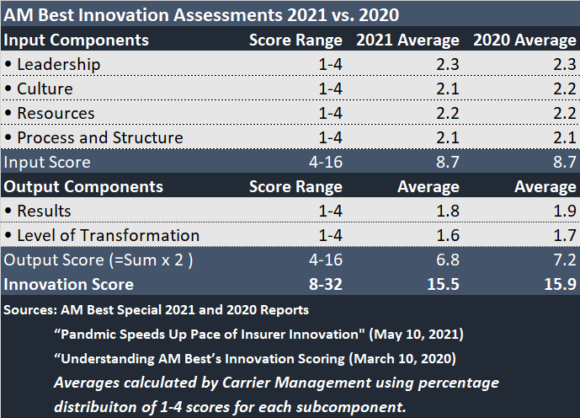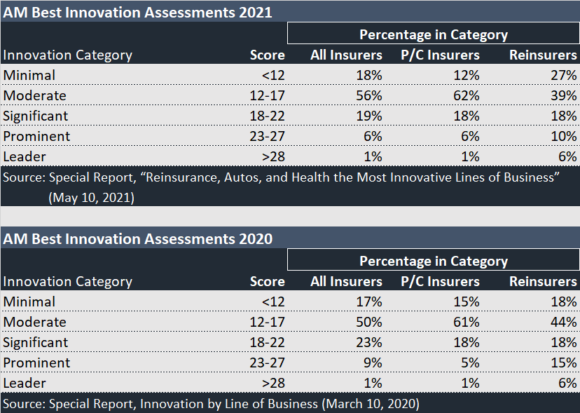Although COVID-19 forced many insurers to seek out innovative solutions, most companies still have room for improvement, according to rating agency AM Best.
In a recent analysis of innovation assessment scores, which the rating agency first introduced into the rating process last year, AM Best found that the scores this year are slightly lower than the preliminary results released ahead of the innovation criteria in 2020. The differences are driven mainly by the challenges of the pandemic, AM Best said.
In particular, in a two-part assessment that measures innovation inputs (items like leadership and culture) and innovation outputs (results and levels of transformation), AM Best found that insurers tend to struggle with output. Basically, they have difficulty transforming innovation efforts into results.

“Developing an innovative culture among insurers has been an ongoing challenge, but COVID-19 upended the industry’s methodically slower pace, causing insurers to act swiftly to adapt to the rapidly changing environment,” the rating agency said. Even with the strides they have made in creating more innovative cultures, however, most companies still score at the lower end on their innovation output scores, “in large part highlighting the obstacles created by the pandemic,” AM Best said in announcing a series of reports detailing its analysis of innovation assessments.
AM Best reported on the distribution of its innovation assessments for rated carriers and individual subcomponents of its innovation input scores (leadership, culture, resources, process and structure) and subcomponents of its innovation output scores (results and level of transformation), in a report titled, “Pandemic Speeds Up Pace of Insurer Innovation,” and in a summary article published on Carrier Management (“One Year In: How Insurers Are Doing On AM Best Innovation Assessments”).
“While the pandemic has forced businesses to cram years’ worth of innovations into one year, most companies still have a long way to go,” co-authors and AM Best associate directors, Jason Hopper and Edin Imsirovic, wrote in their Carrier Management article.
The analysts also provide an overview of the distribution of innovation assessments by financial strength and size category, by line of business and by region in the CM article, with more details available in a series of reports published on AM Best’s website.
Among the findings in one of the reports, “Reinsurance, Autos, and Health the Most Innovative Lines of Business,” the analysts reveal that reinsurers continue to have the best innovation scores, with roughly 16 percent assessed as “prominent” innovators or “leaders” in innovation, compared to only 7 percent of property/casualty insurers.

Another report, “COVID-19 Pandemic Shifts Innovation Benchmarking Results Slightly,” reveals that the most favorable innovation assessments skew toward organizations with higher financial strength ratings.
“Higher-rated companies generally had already made innovation-focused investments and were more prepared to deal with the challenges brought on by the pandemic, while other companies had to make years’ worth of changes instantaneously to improve customer engagement and continue growth opportunities,” the analysts wrote in their summary article for Carrier Management, explaining why that dynamic persisted throughout the pandemic.
The analysts also note that favorable innovation assessments tend to correlate with company size. In particular, with larger amounts of capital at their disposal tend, they tend to have more financial resources, and thereby receive higher scores for the resource input subcomponent of the assessments.
Still, in a video on AM Best’s website, Hopper stressed that it is not true that smaller companies cannot score well on innovation. “Smaller companies can partner with InsurTech companies or MGAs. And new entrants don’t have legacy issues,” which means they can “start fresh with a newer and more-focused innovation process and mentality,” he said.
Was this article valuable?
Here are more articles you may enjoy.



 Stepbrother Suspect in Cruise Ship Death Says He Doesn’t Remember Anything
Stepbrother Suspect in Cruise Ship Death Says He Doesn’t Remember Anything  Cloudy Future for Bourbon Has Jim Beam Closing Distillery for a Year
Cloudy Future for Bourbon Has Jim Beam Closing Distillery for a Year  Severity Was Up, But Will Falling Claims Volume Impact the Profession?
Severity Was Up, But Will Falling Claims Volume Impact the Profession?  Judge Green Lights New York’s Driver’s License Law, Rejecting Trump Challenge
Judge Green Lights New York’s Driver’s License Law, Rejecting Trump Challenge 


